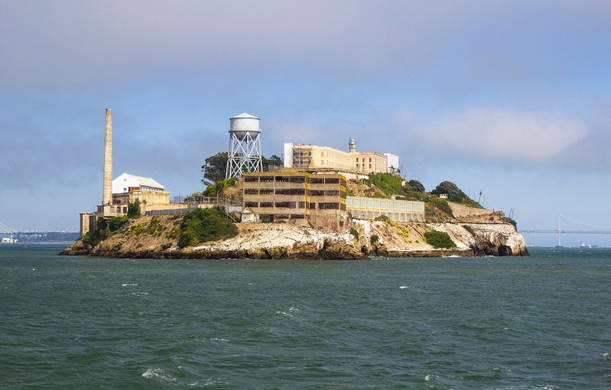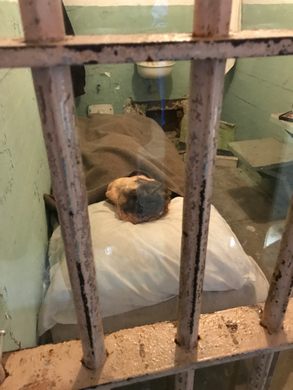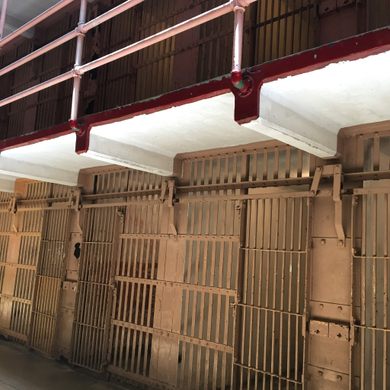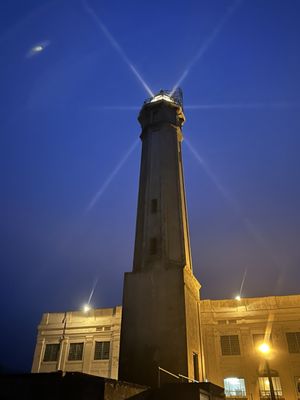Alcatraz Island
Former federal penitentiary & military fortress, now historic landmark
Information
San Francisco, CA 94133 Get directions
Former federal penitentiary & military fortress, now historic landmark




























































































San Francisco, CA 94133 Get directions

"You may know it by its real name or you may know it as “The Rock” (thanks Nic Cage!). It is the prison that was open as a federal penitentiary for 29 years and, at one point, housed gangster Al Capone. It became notorious for failed escape attempts—the island is just 1.25 miles offshore and, lured by the glittering lights of the city, 34 prisoners tried their hand at swimming through the frigid, choppy waters to freedom. Today, you can take a 12-minute ferry ride out to the island and take in the infamous prison up close. Audio tours guide visitors through the main cell block, laundry facility, and chow house. Don’t miss the ruins of the 15-room Warden’s mansion, where lavish parties were held. It was burned to the ground during the 19-month-long occupation of Alcatraz Island by Native American activists in 1970. Outdoor spaces to see are Eagle Plaza, the Recreation Yard, and the island’s colorful gardens, maintained by volunteer gardeners of the Golden Gate National Parks Conservancy." - Kimberley Lovato, Carey Jones

"Tell me: What’s this place all about? You may know it by its real name or you may know it as “The Rock,” (thanks Nic Cage!). It is the prison that was open for 29 years and, at one point, housed gangster Al Capone. It became notorious for failed escape attempts—the island is just 1.25 miles offshore and, lured by the glittering lights of the city, 34 prisoners tried their hand at getting out and swimming through the frigid, choppy waters to freedom. Today, you can take a 12-minute ferry ride to view the ruins of the prison and learn more about the island's history. It’s one of San Francisco’s most popular tourist destinations, so reserve a time slot in advance through Alcatraz Cruises —buying one of their ferry tickets to the island gives you full access to the historic grounds. What’s it like being there? Alcatraz affects its visitors differently: Some are stunned, amazed, or saddened by its history. Others are awestruck by the views of the San Francisco Bay from the island. The vibe can also depend on what time of day you go. During the day, it's a fascinating tour. But, by night, it's creepy in the best way. Is there a guide involved? Very much. When you arrive, you line up to get audio tour headsets. Though the audio tour is long, the commentary is not to be missed. Who comes here? A massive number of visitors come through Alcatraz, from local students coming for school to international tourists, each year. Most take the same route, listening to the headset as they go. Did it meet expectations? The history and stories of Alcatraz are incredible and even the views from the ferry ride will impress. If you like procedurals or true crime podcasts you’ll particularly love it. It does, however, get quite crowded. Make your reservations well in advance and if you can snag a spot on the first morning’s ferry, do it. People on the first boat will have a better time touring before it gets too packed. Many people love the night tour (which books up even sooner than the day tours) for its eeriness and glittering views of the city lights. What kind of commitment is a visit here? Including the ferry trip, Alcatraz will take a minimum of 2.5-3 hours; many visitors spend the better part of their day there. There’s a lot of walking on the island, including a steep hill from the dock to the prison cellhouse." - Lexi Pandell

"Alcatraz, also referred to as “The Rock,” is rich in American history, more so than most people realize. It is the home of the oldest operating lighthouse on the west coast, a Civil War fortress that served as the San Francisco Arsenal, the infamous federal prison, the beginning of the American Indian Red Power movement, and also a bird sanctuary. In 1775 Spaniard Juan Manuel de Ayala named the island “La Isla de los Alcatraces” which translates into “The Island of the Pelicans.” Since then, the earliest recorded owner of the island is Julian Workman, who was assigned by Mexican governor Pio Pico to build a lighthouse on it in June 1846. In 1850 President Millard Fillmore claimed Alcatraz Island for military use only after America gained California in the Mexican-American War. As the American Civil War broke out in the early 1860s, Alcatraz was loaded up with cannons and served as storage and protection of firearms for the San Francisco Arsenal. During the war it was also used to imprison Confederate sympathizers. In 1868, after the building of a brick jailhouse, it was officially designated a long-term facility for military prisoners. The main cellblock was constructed between 1909 and 1912, and an excavated pit was created as a dry moat to increase defensive efforts. The fortress was deactivated as a military prison in 1933 and opened as a federal prison in August of 1934. Through 1963, the prison held many notable criminals like Al Capone, Bumpy Johnson, George “Machine Gun” Kelly, and Robert Franklin Stroud (the Birdman of Alcatraz). However, in all of the 29 years it was in operation, no prisoners ever successfully escaped, or at least none that they have found alive. Fourteen escape attempts were made by 36 different Alcatraz inmates over the years and though almost all were captured or killed in the process, in two escapes in 1937 and June 1962, the inmates disappeared without a trace. The prison assumes they all drowned (quite likely correct in the 1937 case), but over the years there have been sightings of the escapees, leading to much speculation about their possible successful escape. The 1962 escape from Alcatraz inspired a book and movie that brought the prison to national fame. The penitentiary was closed in 1963 due to the high costs of operation in comparison with other prisons as well as the severe eroding of the building due to the salt water. In 1976, Alcatraz Island became part of the National Register of Historic Places, and in 1986 it became a National Historic Landmark." - ATLAS_OBSCURA


"Alcatraz, also referred to as “The Rock,” is rich in American history, more so than most people realize. It is the home of the oldest operating lighthouse on the west coast, a Civil War fortress that served as the San Francisco Arsenal, the infamous federal prison, the beginning of the American Indian Red Power movement, and also a bird sanctuary. In 1775 Spaniard Juan Manuel de Ayala named the island “La Isla de los Alcatraces” which translates into “The Island of the Pelicans.” Since then, the earliest recorded owner of the island is Julian Workman, who was assigned by Mexican governor Pio Pico to build a lighthouse on it in June 1846. In 1850 President Millard Fillmore claimed Alcatraz Island for military use only after America gained California in the Mexican-American War. As the American Civil War broke out in the early 1860s, Alcatraz was loaded up with cannons and served as storage and protection of firearms for the San Francisco Arsenal. During the war it was also used to imprison Confederate sympathizers. In 1868, after the building of a brick jailhouse, it was officially designated a long-term facility for military prisoners. The main cellblock was constructed between 1909 and 1912, and an excavated pit was created as a dry moat to increase defensive efforts. The fortress was deactivated as a military prison in 1933 and opened as a federal prison in August of 1934. Through 1963, the prison held many notable criminals like Al Capone, Bumpy Johnson, George “Machine Gun” Kelly, and Robert Franklin Stroud (the Birdman of Alcatraz). However, in all of the 29 years it was in operation, no prisoners ever successfully escaped, or at least none that they have found alive. Fourteen escape attempts were made by 36 different Alcatraz inmates over the years and though almost all were captured or killed in the process, in two escapes in 1937 and June 1962, the inmates disappeared without a trace. The prison assumes they all drowned (quite likely correct in the 1937 case), but over the years there have been sightings of the escapees, leading to much speculation about their possible successful escape. The 1962 escape from Alcatraz inspired a book and movie that brought the prison to national fame. The penitentiary was closed in 1963 due to the high costs of operation in comparison with other prisons as well as the severe eroding of the building due to the salt water. In 1976, Alcatraz Island became part of the National Register of Historic Places, and in 1986 it became a National Historic Landmark." - ATLAS_OBSCURA


"A dynamic region known for its tech innovation, beautiful landscapes, and vibrant arts scene. Ideal for reunions and social gatherings." - Tina Chadha